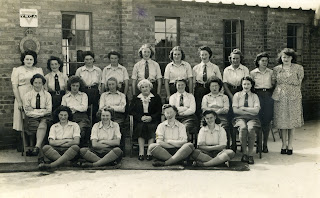Josie Rowland-Jones (nee McKenna) met her husband during the war and was married in 1949. She found it hard to settle despite the friendly people around her. Her husband worked the land - erecting and repairing fences during the war, and most certainly would not have been happy moving to Liverpool to be near to Josie’s family. After the war he worked on construction projects – locally at Nant y Moch, sea defences at Tywyn and Borth before moving on to become a porter/security officer in the National Library of Wales until his retirement twenty five years later. Josie worked in catering at the University whilst raising three children and caring for her in-laws until their deaths in the 1960’s. Her daughter Liz remembers growing up in Aberystwyth, where she attended St. Padarn’s Convent school, and of visiting the town with her mum. There seems to have been a very special bond between Josie and any former Land Army companions that she met. Happy days remembered it seems!
 |
| Olwen and her colleagues enjoying a break |
Olwen Jones also met her husband during the war. He was from Penrhyncoch and had a farming background, having a small-holding with sheep, and was also in the Home Guard. He eventually became a porter in the University. The numerous pictures we have of Olwen’s Land Army Days were only found after the deaths of Olwen and her husband. Apparently Olwen didn’t talk about her work during the war, but did talk a great deal about the friends she had made. One of these friends eventually made her wedding cake. Olwen had been a driver during the war, alongside her work on the land, and eventually became a housewife and ambulance driver in later civilian life. Olwen was in the Land Army from July 1942 to October 1950.
 |
| Olwen and her delivery truck |
After the war the hostel in Bow Street was used for civilian housing whilst the new housing estates were being built. Liz remembers driving past it with her Mum whilst still a child and being told that her Mum had lived there during the war. Liz explained that she thought it looked a bleak and unwelcoming place to spend time or live in!
 |
| Rita, Nancy and Lilian outside the hostel |
The lessons we can take from the experiences of the Land Army girls seems to be we that we should make the most of what we have. The girls had very little in the way of home comforts, entertainment, or leisure time but yet most seemed to have happy memories of those times. They were “doing their bit” to help the war effort, and mostly seemed proud to be engaged in it. The girls seemed to have made their own fun from whatever they could obtain.
 |
| Tea time! |
One of the legacies of the Land Army also seems to be that Lady Denman, a strong feminist, brought attention to the fact that Land Army girls had worked tremendously hard during the war and their efforts should have been treated as all other services. In 1945, Lady Denman wrote to the Minister of Agriculture, R.S Hudson, resigning her position as Honorary Director of the Women’s Land Army in protest at the decision to exclude members of the WLA from Government capital grants to assist in restarting business enterprises. Women’s roles must have come into question after the war possibly leading to the swinging '60’s and beyond.
 |
| Olwen's discharge certificate and letter |
I would like to thank Liz and Brian Ashton and Meinir Davies for agreeing to talk to me via Zoom and to Kate Sullivan for sending me the video of this meeting.
Thanks to Steven Evans and Meinir Davies for all the superb pictures and to Brian Ashton for scanning them all for me to use in my research.
Blog by Kath Phillips




















